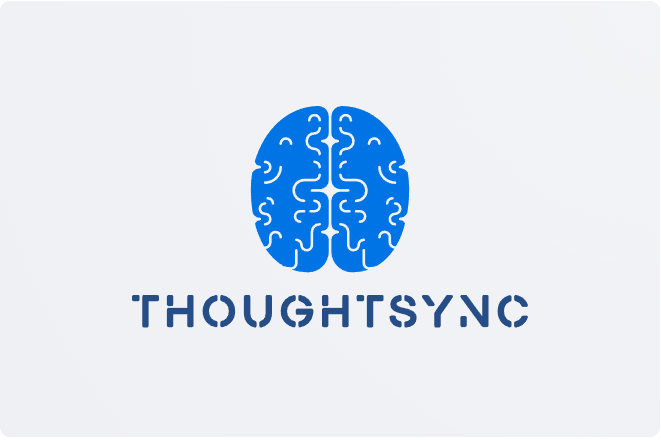ThoughtSync is a CLI tool that allows users to access
their own note collection, comfortably from the command line,
using their own EDITOR.
It offers git support to add and commit changes to users note, with an option to support git remotes and pulling/pushing changes.
ThoughtSync was born to be used with an Obsidian-type vault in mind, but it is compatible with just any note collection contained in a single folder. This collection is commonly referred to as a vault.
ThoughtSync is built in go using the cobra framework and a handful of other go libraries like go-editor and go-git. Some other tools used are:
- mise-en-place, a polyglot runtime manager to handle tool versions, env vars and much more
- mockery, mock generator for go interfaces
- testify, a go toolkit to write tests
- color to print colored text to the terminal
- gotestsum, a wrapper
for the
go testcommand - act for testing github actions locally
- color to print colored text to the terminal
ThoughtSync lets the user open, edit and search through their own note collection. Current features include:
- Editing an existing note;
- Create a new note in any subdirectory in their own vault;
- Create or open the note entry for the current day (for those that keep a daily journal)
- Configure note vault path, journal directory, note format and much more
- Keep track of your vault changes using git and optionally sync it with a remote repository
- Ability to search through notes using popular tools such as ripgrep
- Quickly group notes with a certain tag or containing a certain word
- Quickly read a note content without opening it using
cator similar - Preferences in a single configuration file
- Quickly get and set configuration options
- Git syncing with remote options
- Fuzzy find notes in your vault and open them
- See the vault git status
- Open a tree view of your vault for easy navigation
ThoughtSync can be installed as any go product with go install:
go install github.com/lcampit/ThoughtSyncor simply by downloading the executable from the releases page
It's suggested to use an alias such as alias ts=ThoughtSync
The following is a list of available commands:
thoughtsync new <filename.txt>to create a new note in your vaultthoughtsync todayto create and/or open the journal note of todaythoughtysync gitcontains all git-related commands:syncto stage, commit and optionally push your vault to your remote git repository.statusto see the current vault git statuspushmanually pushes changes to the remote vault git repositorypullmanually pulls changes from the remote vault git repository
thoughtsync configcontains all options related to the tool configuration:- The base commands prints the current configuration options in a nicely indented view
setsets a configuration options using the given value and saves the configuration changes
ThoughtSync can be configured using a thoughtsync.yaml file
contained in $XDG_CONFIG_HOME/thoughtsync/thoughtsync.yaml
The configuration file is defined as follows:
- The
vaultsection contains all configuration related to the note vaultpathcontains the full path to the vault main directoryextensioncontains the extension of the notes files in your vault (with dot)
- The
journalsection contains all configuration related to the journal notes:directorycontains the path, relative tovault.path, to store your journal notes informatdefines the format used to give a name to your journal notes, such as "2006-02-01", without extension- currently supported formats are
YYYY-MM-DD,MM-DD-YYYY
- currently supported formats are
- The
gitsection contains all options related to managing your notes with git:enableenables git supportremoteenables git remote support and pushing to the remote withthoughtsync sync(has no effect ifgit.enableis false)remote-namesets the git remote name to push to / pull fromcommit-messagecontains the commit message used withthoughtsync git syncsshto use ssh authentication for your vault git-related commands
Here's an exhaustive configuration example:
# Contains all vault specific options
vault:
path: $HOME/vault # Default: $HOME/thoughtsync
extension: ".txt" # Default: ".md"
# Contains all journal specific options
journal:
directory: my-own-journal # Default: journal
format: "YYYY-MM-DD" # Default: "YYYY-MM-DD"
# Contains all git specific options
git:
enable: true # default false
remote: true # default false
remote-name: "remote" # default origin
commit-message: "thoughtsync sync" # default "thoughtsync: Synced with git"
ssh: true # default falseNote
Some configuration options need to be the expected type, i.e. booleans for the enable/disable options. If these options provided from the configuration file are not valid, the default one will be silently used
The CLI itself has a proper help message accessible
with the --help or -h flags. If you clone the repo,
there are some pre-built tasks defined to make
the development experience easier.
Assuming mise is installed:
mise run buildwill build the project in a single executableThoughtSyncmise run testwill run tests
Contributions are welcome! Feel free to clone the project and create pull requests or add issues.
I've been caressing the idea of building my own second brain with notes since I had a job. Being able to write down stuff helps me keep a clear head, so I started building my own second brain using Notion. I've always wanted to be fluent with the command line, but I could not find proper ways to access my notes in Notion through the CLI, at least until I found out this video that showed me how to combine Neovim with Note taking in Obsidian. I made the switch, but I noticed how the video author used bash scripts to access its own vault. Surely there is some CLI tool I can use for that, right? no? Time to create my own then!



